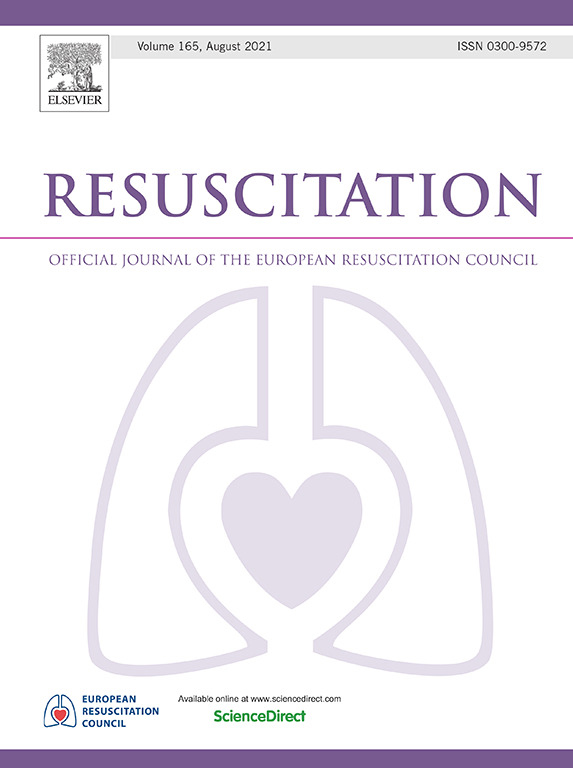Vasopressor or advanced airway first in cardiac arrest?
IF 6.5
1区 医学
Q1 CRITICAL CARE MEDICINE
引用次数: 0
Abstract
Background
While resuscitation guidelines emphasize early vasopressor administration and advanced airway management, their optimal sequence remains unclear. We sought to determine the associations between vasopressor-airway resuscitation sequence and out-of-hospital cardiac arrest (OHCA) outcomes in the Pragmatic Airway Resuscitation Trial (PART).
Methods
We analyzed data from the PART trial. For each patient we determined times of first vasopressor administration (epinephrine or vasopressin), and successful advanced airway insertion (laryngeal tube or endotracheal tube). We classified each case as vasopressor-first or advanced airway-first. We used Generalized Estimating Equations to determine associations between vasopressor-airway sequence and outcomes (72-hour survival, return of spontaneous circulation (ROSC) on emergency department arrival, survival to hospital discharge, hospital survival with favorable neurologic status) and CPR outside of recommended parameters (chest compression fraction <0.8, chest compression rate <100 or >120 per min, or ventilation rate <8 or >12 breaths/min), adjusting for confounders.
Results
Of 3,004 patients in the parent trial, we analyzed 2,404, including 1,821 vasopressor-first and 583 advanced airway-first. Median intervention times: ALS arrival-to-vasopressor 8 min (IQR 6–11) and ALS arrival-to-airway 11 min (8–15). Compared with airway-first, vasopressor-first sequence was not associated with 72-hour survival (adjusted OR 0.96; 95% CI: 0.71–1.31), ROSC (0.83; 0.66–1.06), hospital survival (1.09; 0.68–1.73), or hospital survival with favorable neurologic status (0.97; 0.53–1.78). Vasopressor-first sequence was not associated with non-compliance with recommended CPR performance parameters.
Conclusions
Vasopressor-airway resuscitation sequence was not associated with OHCA outcomes or CPR quality.
心脏骤停时先用血管加压素还是先用高级气道?
背景:尽管复苏指南强调早期使用血管加压素和高级气道管理,但其最佳顺序仍不明确。我们试图确定务实气道复苏试验(PART)中血管加压-气道复苏顺序与院外心脏骤停(OHCA)预后之间的关系:我们分析了 PART 试验的数据。我们确定了每位患者首次使用血管加压素(肾上腺素或血管加压素)和成功插入高级气道(喉管或气管插管)的时间。我们将每个病例分类为先使用血管加压素还是先使用高级气道。我们使用广义估计方程来确定血管加压-气道顺序与预后(72 小时存活率、急诊科到达时自发性循环恢复(ROSC)、出院存活率、神经系统状态良好的住院存活率)和超出推荐参数(胸外按压分数 120 次/分钟或通气率 12 次/分钟)的心肺复苏之间的关系,并对混杂因素进行了调整:在母试验的 3,004 名患者中,我们分析了 2,404 名患者,包括 1,821 名首先使用血管加压器的患者和 583 名首先使用高级气道的患者。干预时间中位数:ALS到达到使用血管加压器的时间为8分钟(IQR为6-11),ALS到达到使用气道的时间为11分钟(8-15)。与气道先行相比,血管加压先行顺序与 72 小时存活率(调整后 OR 0.96;95% CI:0.71-1.31)、ROSC(0.83;0.66-1.06)、住院存活率(1.09;0.68-1.73)或具有良好神经状态的住院存活率(0.97;0.53-1.78)无关。血管加压先行顺序与不遵守推荐的心肺复苏性能参数无关:结论:血管加压-气道复苏顺序与 OHCA 结果或心肺复苏质量无关。
本文章由计算机程序翻译,如有差异,请以英文原文为准。
求助全文
约1分钟内获得全文
求助全文
来源期刊

Resuscitation
医学-急救医学
CiteScore
12.00
自引率
18.50%
发文量
556
审稿时长
21 days
期刊介绍:
Resuscitation is a monthly international and interdisciplinary medical journal. The papers published deal with the aetiology, pathophysiology and prevention of cardiac arrest, resuscitation training, clinical resuscitation, and experimental resuscitation research, although papers relating to animal studies will be published only if they are of exceptional interest and related directly to clinical cardiopulmonary resuscitation. Papers relating to trauma are published occasionally but the majority of these concern traumatic cardiac arrest.
 求助内容:
求助内容: 应助结果提醒方式:
应助结果提醒方式:


